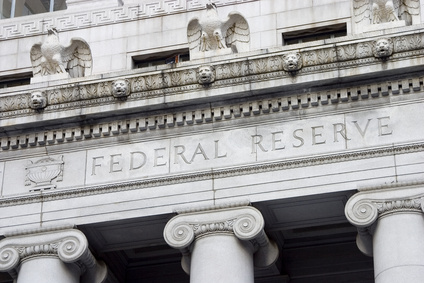Nearly all major Global Central Banks have adopted a more formal easing bias in their word cues, with the Fed, ECB and BoJ standing ready to deliver further easing as global growth slows – weighed down by geopolitical tensions. Meanwhile, the BoE hasn’t joined the dovish herd just yet, even though it highlighted downside risks to the growth outlook. On the other hand,the Bank of Canada steady policy outlook stands out among the core Centra Banks. USD under pressure as sentiment continues to wane. USDJPY trades under 107.00 and Gold breaches six-year highs.
Bonds rallied last week as the Fed and ECB took dovish turns, underpinning escalating market expectations that further accommodation is due from both banks this year. Equities also made headway, with Wall Street marking fresh record highs before running into resistance. Yet event risk remains elevated this week, with US-Iran tensions high and the G-20 taking place in Japan. Presidents Trump and Xi are schedule to meet, which could produce a flurry of market moving headlines and tweets on US-China trade.
A few key US releases will help gauge the impact of trade uncertainty on the economy. Fedspeak resumes after the blackout period, with Fed Chair Powell headlining a list of key players set to speak this week.
However lets have a closer look on each banks Policy Outlook ahead their next meeting in July.

US: The FOMC left rates unchanged but lost patience with its policy stance, dropping that characterization of the policy approach in favor of noting that “uncertainties about this outlook have increased.” And indeed, while the rising uncertainties were a factor behind the rate cut fever that overtook the markets, they were also a factor behind why the FOMC wasn’t ready to ease policy as soon as June.
Eventhought, that dovish shift was well anticipated, there was more to come that supported the uber-dovish view in the markets and expectations for at least 75 basis points in rate cuts this year. Those included a larger than expected downgrade in the dots, the Chair’s refrain from using “transitory” to describe low inflation, a downshift in the inflation view, and a dissent from the dove Bullard.
So Chair Powell and Company managed to spin a dovish tale, threading the needle perfectly as bond and stock bulls were satisfied by the possibility of rate cuts, but without any real commitment from the FOMC to lower rates anytime soon. However, the futures pricing in a cut as soon as July, thanks to rising tensions in the Middle Ease, elevated uncertainties over a US-China trade deal, signs that the tariffs are weighing on growth, and and low inflation.
Eurozone: The ECB kept policy rates on hold at June meeting, but it has changed its tune — the official baseline scenario now is that further easing measures are underway unless the overall outlook improves to an extent that would signal a pick up in inflation pressures in the foreseeable future. With geopolitical tensions rising, rather than abating, and the UK lining up a Brexit hard liner to succeed May, the chances are increasing that the economic backdrop will get worse rather than better.
The ECB is not expected to act immediately, but clearly the chances that Draghi will deliver one last parting gift before his departure at the end of October, clearly are pretty high. Meanwhile, the chances of Merkel’s preferred candidate for the post of European Commission President sinking, the chances that Bundesbank President Weber will take Draghi’s post are improving.
 Japan: The BoJ held policy steady, while highlighting downside risks from exports on the growth outlook. The Bank kept in place its yield-curve control program and asset purchases, matching widespread expectations.
Japan: The BoJ held policy steady, while highlighting downside risks from exports on the growth outlook. The Bank kept in place its yield-curve control program and asset purchases, matching widespread expectations.
In January, BoJ reduced its inflation projections, with CPI for fiscal year (FY) 2018 now seen at 0.8% (was 0.9%), FY 2019 at 0.9% (was 1.4%) and FY 2020 at 1.4% (was 1.5%). Japan’s fiscal year begins in April.
The BoJ is anticipated to maintain its current extraordinary level of stimulus as they wait and see how global growth progresses this year, while it has warned that chronic ultra-accommodative policy “could destabilize the financial system,” although these risks were not judged to be significant at the present juncture.
Among the core central banks, the BoJ is firmly poised to be “low for longest“.
 UK: The BoE kept policy settings unchanged, but highlighted downside risks to the growth outlook, which coming on the heels of dovish messages from ECB, BoJ and Fed. The details of the minutes show that the BoE hasn’t joined the dovish herd just yet, even though it acknowledges that its views are increasingly at odds with what markets are expecting.
UK: The BoE kept policy settings unchanged, but highlighted downside risks to the growth outlook, which coming on the heels of dovish messages from ECB, BoJ and Fed. The details of the minutes show that the BoE hasn’t joined the dovish herd just yet, even though it acknowledges that its views are increasingly at odds with what markets are expecting.
ECB officials by contrast, continue to re-enforce Draghi’s Sintra message that rate cuts and further asset purchases are on the cards if things don’t improve.
Looking further ahead the BoE noted that the risk of a no-deal scenario has increased.However, it still maintained not only that in the central scenario of a relatively smooth Brexit transition rates will have to rise, but also reiterated that the central bank’s monetary policy reaction to a no-deal outcome is not certain and could be either way. At the same time, the minutes highlighted that the labour market remains tight and that longer term marked based indicators of inflation expectations continue to diverge from those elsewhere and that some indicators of U.K. longer-term household inflation expectations have risen, even if shorter term measures remain close to their historical averages.
 Canada: The Bank of Canada steady policy outlook stands out among the core central banks. Governor Poloz and other central bank officials have maintained an effectively neutral stance regarding future policy moves even as the Fed and ECB seem to be leaning in the direction of additional accommodation.
Canada: The Bank of Canada steady policy outlook stands out among the core central banks. Governor Poloz and other central bank officials have maintained an effectively neutral stance regarding future policy moves even as the Fed and ECB seem to be leaning in the direction of additional accommodation.
The key to the BoC’s policy resilience has been the performance of the economy. All of the crucial reports that have been released since the BoC’s May 29 announcement, have been consistent with an economy that is on the mend after the slowing in Q4 and Q1 that was driven by the oil price shock.
Overall expectations remain for no change in rates from the BoC this year, as they leave the currently accommodative 1.75% target in place to facilitate the economy’s return to full capacity growth and 2.0% core inflation. Uncertainties remain elevated, notably around the outlook for trade and crude oil, however the BoC’s current policy setting is well positioned to deal with the realization of both upside or downside risks.
Click here to access the Economic Calendar
Andria Pichidi
Market Analyst
Disclaimer: This material is provided as a general marketing communication for information purposes only and does not constitute an independent investment research. Nothing in this communication contains, or should be considered as containing, an investment advice or an investment recommendation or a solicitation for the purpose of buying or selling of any financial instrument. All information provided is gathered from reputable sources and any information containing an indication of past performance is not a guarantee or reliable indicator of future performance. Users acknowledge that any investment in Leveraged Products is characterized by a certain degree of uncertainty and that any investment of this nature involves a high level of risk for which the users are solely responsible and liable. We assume no liability for any loss arising from any investment made based on the information provided in this communication. This communication must not be reproduced or further distributed without our prior written permission.




















